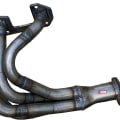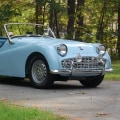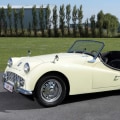The Triumph TR series of sports cars has become a classic British auto icon. The TR series is an elegant, powerful, and timeless design that has been loved by car enthusiasts for decades. But did you know that there are other Triumph TR models that also deserve recognition? This article provides a comprehensive overview of the lesser-known Triumph TR models, and explains why they are just as worthy of admiration as the classic TRs. The Triumph TR is a series of British sports cars that were first developed by the Standard Triumph Motor Company in 1953. The first model released in the series was the TR2, which was powered by a 2.0L four-cylinder engine and featured a lightweight chassis. This model was followed by the TR3, which was introduced in 1955 and had a larger 2.2L engine and improved suspension.
The TR4 was released in 1961, and featured a more powerful 2.5L engine, as well as some styling changes. The most iconic of the Triumph TR models is the Spitfire, which was introduced in 1962 and featured the same 2.0L engine as the TR2 but had a more aerodynamic body and improved suspension. The Spitfire also featured a removable hardtop roof, allowing for open-top motoring. The Spitfire was followed by the GT6 in 1966, which featured a larger 2.0L six-cylinder engine and four-speed manual transmission.
This model was designed to be a more performance-oriented version of the Spitfire, and it featured improved handling and acceleration. The final model in the Triumph TR series was the Herald, which was introduced in 1969. This model had a 1.3L four-cylinder engine and was designed to be an entry-level model for those who wanted to experience the style of a Triumph without the high cost of one of the larger models. The Herald also featured improved interior comfort and convenience features, such as reclining seats and improved dash layout. Each of these models had its own unique features and specifications. The Spitfire, for example, had an upgraded suspension system for better handling, as well as an improved interior with leather seating options. The GT6 had an improved engine with increased power output and improved handling characteristics, while the Herald had a simpler interior with fewer features but still offered decent performance for its size.
These models were generally well received by critics, although some complained about the build quality of some parts. The Spitfire was praised for its performance and handling, while the GT6 was praised for its power and acceleration. The Herald was generally seen as an economical alternative to the other two models, but it still offered decent performance. In terms of sales figures, the Spitfire outsold both the GT6 and Herald combined. It is estimated that over 200,000 Spitfires were produced between 1962 and 1980, while the GT6 sold around 65,000 units and the Herald sold around 30,000 units between 1969 and 1975. The Triumph TR series of sports cars has remained popular since its inception in 1953. Each model offered something different to its drivers, be it performance, style, or economy.
Despite their age, these classic British sports cars are still enjoyed by enthusiasts today.
The Herald
The Herald was a model of Triumph TR that was introduced in 1959. It was a two-door saloon car that was based on the Standard 8, but with a higher specification. It was powered by an 1147cc engine and had a top speed of 77mph. The Herald was popular for its practicality and affordability, and it had several design features that made it unique, such as a split-level rear window and an unusual boot lid. Over time, the Herald was updated with various changes to its design, including a larger 1,296cc engine and a revised interior.It also had several special editions, such as the convertible Herald 13/60 and the estate Herald 12/50. The Herald was well-received by the public and remained in production until 1971.
The GT6
The Triumph GT6 was introduced in 1966 and was a fastback coupé version of the Spitfire. It featured a 6-cylinder engine with a four-speed manual transmission. The car's sleek lines and attractive interior were well-received by critics, who praised its performance and handling.Over time, the GT6 underwent several design changes, including a larger engine, improved suspension, and more luxurious interior appointments. The GT6 Mk III was the final incarnation of the model, featuring a 2.5 liter six-cylinder engine with a four-speed manual transmission. It was also equipped with an overdrive on third and fourth gears. Other features included an upgraded interior with full leather seating, power steering, and air conditioning. The GT6 was popular with enthusiasts due to its combination of performance and style.
It was praised for its handling capabilities and was considered a good value for money compared to other sports cars of its era. It was also noted for its superior build quality compared to other Triumph models. Despite its popularity, the GT6 was discontinued in 1973 as sales had dwindled in the wake of rising fuel prices.
The Spitfire
The Triumph Spitfire is a small British sports car that was produced by the Standard Triumph Motor Company between 1962 and 1980. It was designed as a replacement for the Herald, and was initially offered with a 1,147 cc engine.The Spitfire had a traditional sports car layout, with the engine mounted at the front and driving the rear wheels. It featured an independent front suspension with coil springs and a live rear axle with semi-elliptic leaf springs. The Spitfire was widely praised for its performance, handling and relatively low price. Over the years, the Spitfire was developed and changed, offering a range of engines from 1,296 cc to 2,000 cc.
It was also offered with a Mark III version featuring a revised interior, a hardtop roof and an optional overdrive transmission. The Spitfire was well-received by the public and press alike and became one of Triumph's most successful models. The Spitfire was designed by Giovanni Michelotti and featured an aerodynamic body shape that resembled Italian sports cars of the time. It was powered by a 1,147 cc four-cylinder engine which produced 63 bhp (47 kW) at 5500 rpm. The engine was mated to a four-speed manual transmission with an optional overdrive. It was also offered with a Mark III version featuring a revised interior, a hardtop roof and an optional overdrive transmission. The Spitfire was well-received by the public and press alike and became one of Triumph's most successful models. The Spitfire was designed by Giovanni Michelotti and featured an aerodynamic body shape that resembled Italian sports cars of the time. It was powered by a 1,147 cc four-cylinder engine which produced 63 bhp (47 kW) at 5500 rpm. The engine was mated to a four-speed manual transmission with an optional overdrive.
The Spitfire featured an independent front suspension with coil springs and a live rear axle with semi-elliptic leaf springs. It also had front disc brakes and rear drum brakes. Over the years, the Spitfire was developed and changed. In 1965, the engine was increased to 1,296 cc and produced 68 bhp (51 kW). In 1967, the Mark II model was introduced which featured a revised interior and larger brakes.
In 1970, the Mark III version was released which featured an improved dashboard, roll-up windows, 14-inch wheels, an optional hardtop roof and an optional overdrive transmission. In 1975, the engine was increased to 1,998 cc and produced 90 bhp (67 kW). The final Spitfire 1500 model was released in 1980. The Triumph Spitfire is widely considered to be one of Triumph's most successful models. It was praised for its performance, handling and relatively low price.
The Mark III version in particular was praised for its improved interior and optional hardtop roof. The Spitfire remains a popular classic car today. The Triumph TR models, such as the Spitfire, GT6 and Herald, have remained iconic pieces of British automotive history. Each model had its own unique features and specifications that made them stand out from the competition. The Spitfire was renowned for its light weight and agility, while the GT6 offered a more refined and powerful driving experience.
The Herald was a versatile vehicle with great practicality. These vehicles have had a huge influence on modern-day sports cars, with their iconic designs, reliable performance, and timeless style. Through their longevity, these other Triumph TR models have earned a lasting place in the hearts of car enthusiasts around the world.


